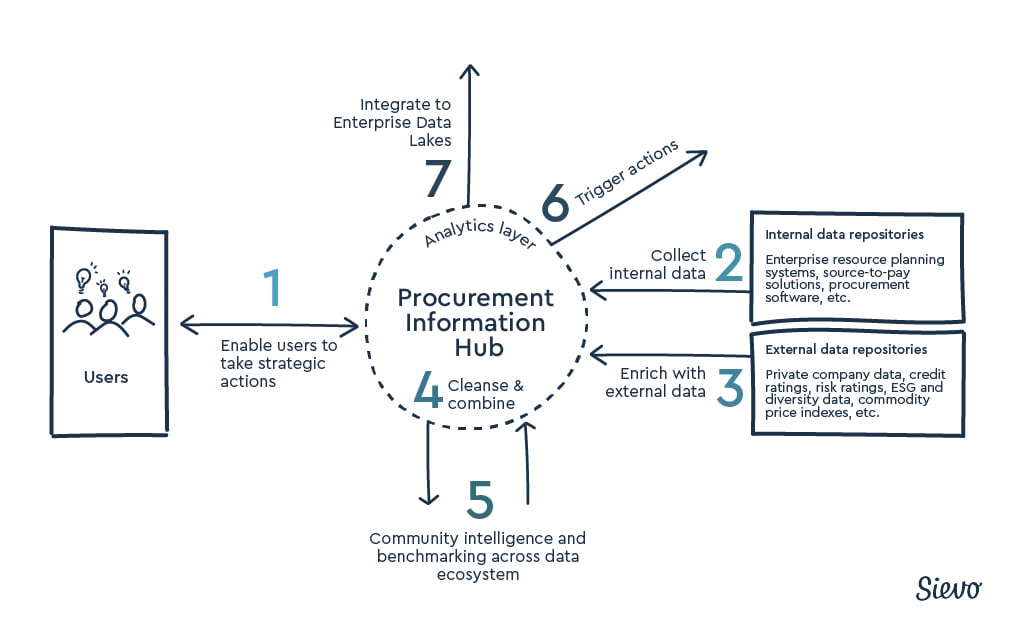Procurement analytics uses quantitative and analytical methods to derive actionable insights from procurement data to improve operational performance and deliver value.
Is procurement analytics the same as spend analytics? No, these terms are sometimes used interchangeably, but they are different.
Procurement analytics is much broader and far beyond identifying where the money went and where the potential cost savings are hiding.
Procurement analysis can be
- reactive,
- advanced, or
- predictive analytics.
With forward-looking analytics, opportunities beyond cost reduction are found. These opportunities include improving supplier performance, mitigating risk, and providing valuable inputs to category and sourcing strategies.
Hungry for more? Procurement Analytics Demystified has everything you need to know -- read the guide here.
7 Benefits of Procurement Analytics
Many procurement organizations still base their decision-making on spend cubes. When we focus on more than analyzing spend cubes, we can not only make better purchasing choices but also deliver more benefits to the business.
1. Promote better supplier performance
Building collaborative partnerships with key suppliers is one of the main drivers of business success and a resilient supply chain.
Reviewing a supplier’s realized performance against pre-set measures can establish areas for improvement and development. Fact-based discussions are the most productive as they eliminate any personal bias.
2. Inform category management and strategic sourcing
Data classified into predefined sourcing categories can be used to identify areas of opportunity. These include supplier consolidation and regrouping sub-categories and commodities into new spend trees for better efficiency and management.
3. Product or service should-cost analysis
Category managers can do a deep dive into the bill of material (BOM) and assess the cost level compared to market prices and material price forecasts.
Example:
Toothpaste consists of raw materials such as abrasives, chemical additives, sweeteners, and water. It needs a plastic tube and a closure. Each tube is packaged in a cardboard sleeve and then packed in cartons for delivery. The buyer must answer questions like:
- How much do we pay for each raw ingredient vs. the market price?
- Which supplier gives us the best price for plastic tubes?
- How can we reduce our packaging requirements?
4. Reduce risk and drive compliance
One of the most valuable benefits of data analysis is limiting and mitigating risk. It can highlight:
- Problems with the security of supply and potential supplier failures
- Fluctuations in raw material prices and currency transactions
- Reputational, social, and environmental risks
- Non-compliance to contract and maverick spending
5. Better benchmarking
Benchmarking internally provides the scope to make comparisons across geographies, divisions, and departments. How does the spend this year compare to that of last year? Does a specific division make better use of supply agreements than the other? Companies with devolved operations can identify areas for consolidating suppliers and reveal areas where better sourcing decisions can be made.
External benchmarking also requires a baseline, in other words, the current spend status or price level. Procurement can use this information to compare with what other similar organizations are achieving. Not only on pricing but supplier service levels, compliance, delivery performance, diversity, and sustainability. The main aim of benchmarking is to measure against similar operations to identify gaps and prioritize improvements.
6. Open new ways of achieving ESG goals
Companies are increasingly reviewing their environmental, social, and governance (ESG) goals. One objective is to expand the supplier base to include more diverse suppliers, i.e., previously disadvantaged people and their businesses. Procurement analytics illuminate these intent-to-action gaps.
We can also ensure that suppliers on the database fully comply with statutory laws and other certifications and operate in line with our sustainability commitments.
7. Improve stakeholder relationships by sharing robust, unquestionable, powerful data
Good working relationships between procurement and internal stakeholders are not easy to achieve. Verified, complete, and reliable information creates trust and a firm base for meaningful discussions. Data can be a dialogue builder and showcase procurement contribution to business performance. Negotiations with suppliers are also strengthened when both parties have access to the same information and can prepare based on historical facts.
Procurement analytics is a key tool for realizing more than savings and controlling spend. It provides transparency and visibility into areas that would be hidden otherwise. AI is enhancing data usability so that decisions can be made confidently.
Understanding your data is vital for future planning, focused sourcing efforts, and realistic budgeting. Are you getting valuable, timely, and hyper-relevant insights from your procurement data?
Software solutions in procurement analytics
MS Excel spreadsheets with static data are no longer adequate. Cloud-based software-as-a-service (SaaS) solutions have overtaken desktop software applications.
New software tools simplify and streamline the laborious process of analyzing “big data” and turn it into practical intelligence. They go beyond historical spending to help predict what we will or expect to spend, a bonus for budgeting. Available solutions apply artificial intelligence (AI) algorithms and automation techniques to shed light on the data.
Software solutions alone will not deliver the best results. Technology provides the tools, but capable people and lean processes are vital to your success with procurement analytics.
What is the procurement information hub?
The procurement information hub is a vision that isn't always a reality in companies. It's a centralized service that connects all procurement data from your systems, solutions, or core business platforms. This procurement data hub orchestrates the connections to each system and the data flow amongst them.

Image: how procurement analytics connects to many other systems, users, and processes within a procurement information hub.
Efficient decision-making relies on centralized data and is readily available to approved users. After data extraction must be organized, cleansed, and classified before it is used.
Data that has been fully processed and constantly updated becomes an information library. You can interrogate and look up the relevant sections or chunks for the purpose you need, whether it's category management, savings validation, or procurement development.
Header photo by: @johnnyhammer (unsplash.com)



